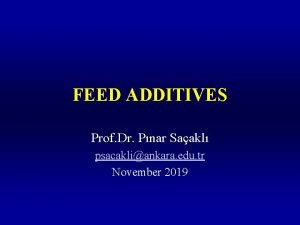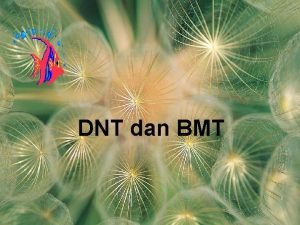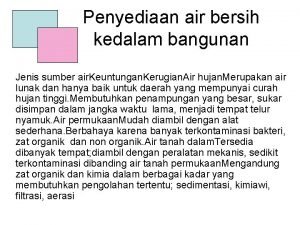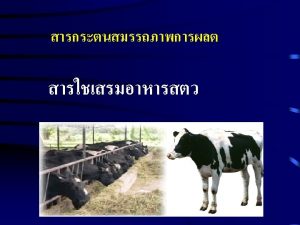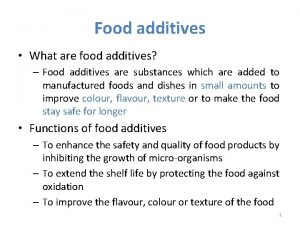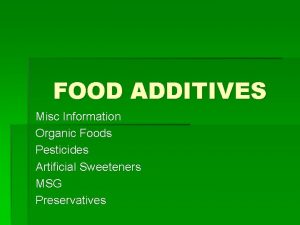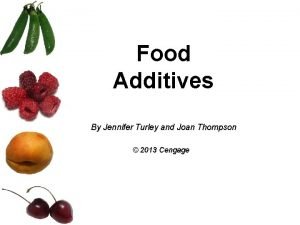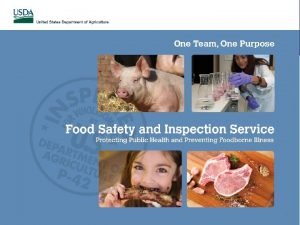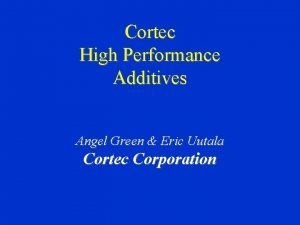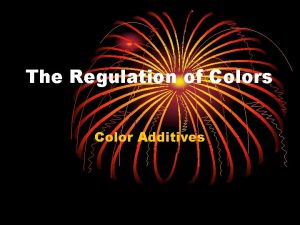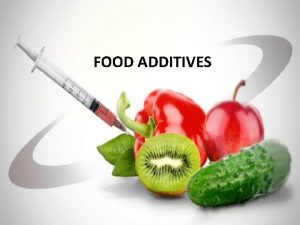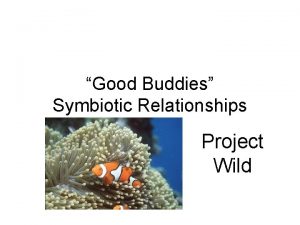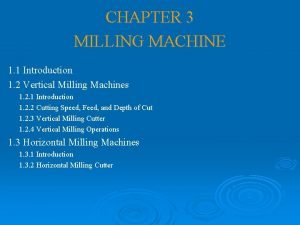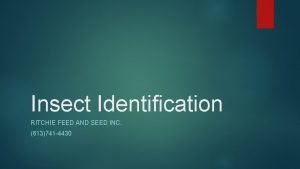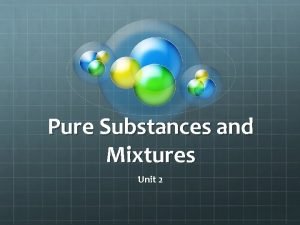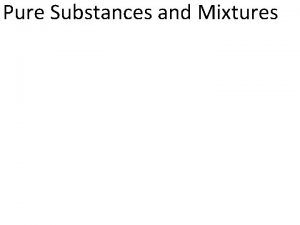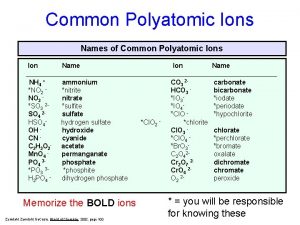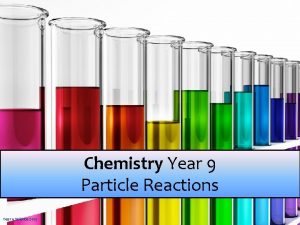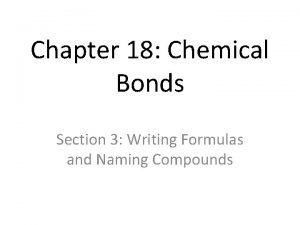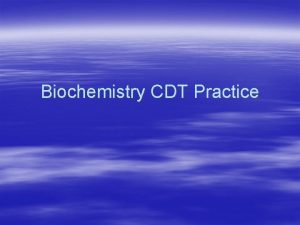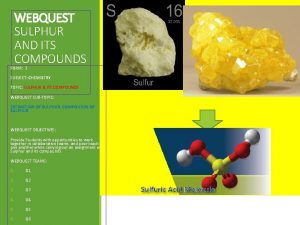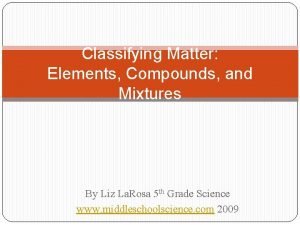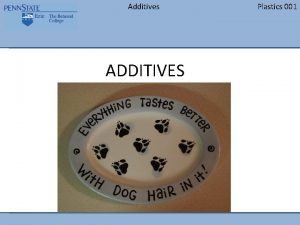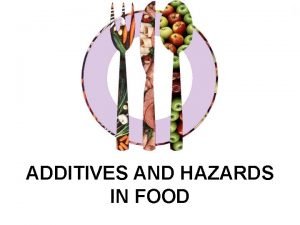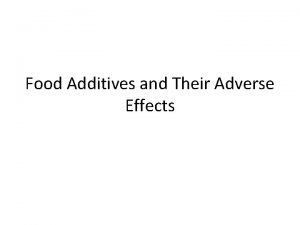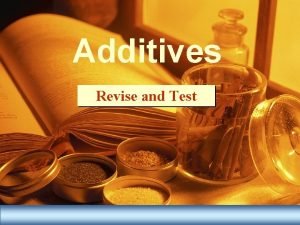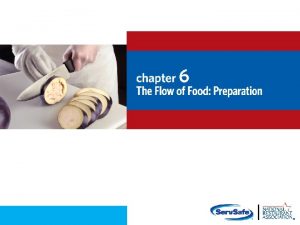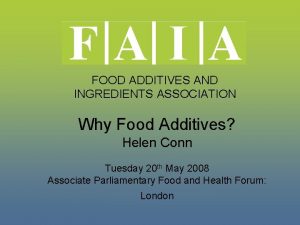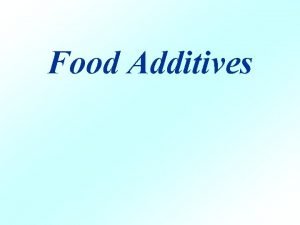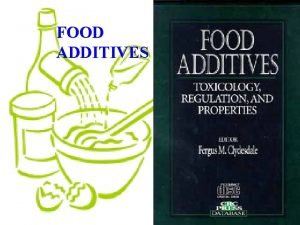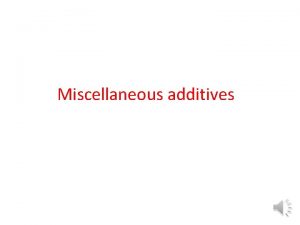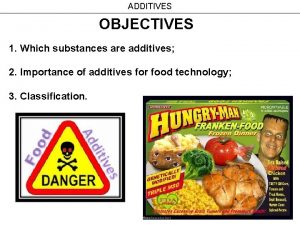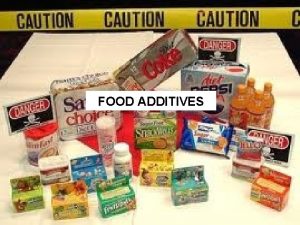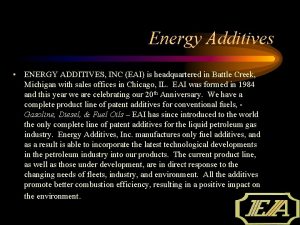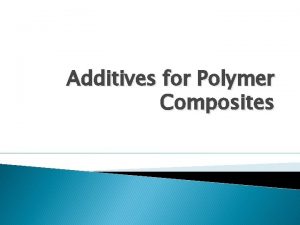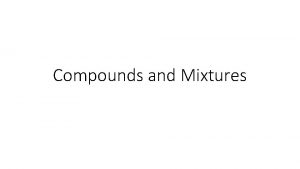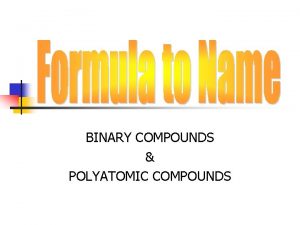Feed Additives and Growth Promotants Feed Additives Compounds


















































- Slides: 50

Feed Additives and Growth Promotants

Feed Additives • Compounds that are added to the diet – other than to supply nutrients to the animal • Example: Antibiotics…no “nutrient requirement” for antibiotics • Urea is not considered feed additive – provides a source of dietary protein (in the form of nitrogen) • Additives used to enhance production efficiency and improve health

Feed Additives • Feed additives used in small quantities eg Melengesterol Acetate (MGA) • Toxicity and end-product residue…. mixing, delivery and consumption critical • Most feed additives are regulated for these reasons • No one…not even a vet…can authorize use off label • Feed industry developed premixes for effective and safe use

“ It is essential to abide by recommended feeding levels with any feed additive”

Regulation of Additives • US- Federal Food and Drug Administration (FDA) • Canada- Food Production and Inspection Branch of Agriculture Canada

Feed label requirements • • • “medicated” must appear under the name of the feed Purpose of the drug Name and amounts of all active drugs Required withdrawal period Cautions against misuse Directions for the use of the feed

Mixing and residue avoidance • Important for safe use • May result in higher production costs • Undesirable side effects

Financial loss includes • Carcasses may be condemned • Additional regulations or restrictions • Animals are held until they are free of the illegal substance

Mixing recommendations • Know the labeled uses, mixing instructions, and withdrawal times • Clean the mixer before use • Premix the drugs in a large enough quantity • Follow the manufacturer’s instructions • Establish order of mixing

Keeping Records • • • Date the batch was mixed Mixing order and the amount of medication Mixing time for the batch Location where the feed is stored Number, age, and weight of the animal fed Medication that was used, the amount, and the concentration • Date of cleaning equipment

Health concerns • • Resistant strain of microorganisms Ban would raise costs of animal product of the consumer Increase the death loss among animals being raised Possible carcinogenic effects

Effects of Feed Additives • Primary Effects: ─ Improve feed efficiency ─ Promote faster gains ─ Improve animal health ─ Increase production of animal products • Secondary Effects: ─ Reduce acidosis, coccidiosis, bloat, liver abscesses, suppress estrus and control foot rot.

Kinds of feed additives and Hormones • • Antimocrobial Drugs Hormones and Hormonelike Compounds Anthelmintics Other Feed Additives

Antimocrobial Drugs • Antibiotics – Produced by living microorganisms – Chlortetracycline, neomycin, oxytetracycline. Penicillin. Streptomycin, tylosin • Chemoantibacteral – Made from chemicals – Carbadox, furazolidone, nitrofurazone, sulfamethazine

Antibiotics • Classified as antibacterial agents – Limit growth of certain bacteria • Bacteria can cause clinical sickness or subclinical reductions in health (morbidity) that reduces performance • Generally approved for low-level use • Animal response to antibiotics depends on feeding conditions at the time they are used – Difficult to quantify actual response that can be expected

Antibiotics – Many antibiotics are normally produced in organisms found naturally in the soil & other places – People exposed for centuries – Generally, used correctly results in healthier animals – No risk to people or livestock?

Antibiotics • The primary reason to feed antibiotics to ruminants is to control liver abscesses, foot rot & secondary infections/diseases as a result of shipping stress • Control of liver abscesses is the primary reason to continuously feed antibiotics – Cattle on high grain diets: • episodes of acidosis = liver damage and infection

• Chlortetracycline – Aureomycin, Aureo S 700 – Numerous recommendations based on production level of animal – Receiving calf AS 700 – 350 mg of each • 48 hour withdrawal time • Aureomycin – 5 days only • AS 700 – 28 days

• Oxytetracyline – Terramycin – 75 mg/hd/d = liver abscesses (cattle) – 0. 5 - 2. 0 g/hd/d = shipping fever complex (cattle) • Feed 3 - 5 days before & after arrival • 7 day withdrawal time • Tylosin – Tylan – 8 - 10 g/t or 60 - 90 mg/hd/d (cattle) – Cleared for use with Rumensin and/or MGA

Hormones and Hormonelike Compounds • Naturally produced in the animal’s body • Regulate many body functions, such as growth, metabolism, and reproduction • Increase the rate of protein synthesis and muscle development • Improve feed efficiency and increase the rate of growth

Hormone Implants • Contain active ingredients that are hormone like • Side effects include: – Buller steers, high tailheads, and udder development • Kinds of implants: – Ralgro. Synnovex. Imlus-S. compodose. Ravalor-S

Implanting Procedure • • • Restrain thee animal Don’t use an instrument with a dull needle Clean needle and implantation site Implant on the back surface of the ear Point instrument toward the head Withdraw the needle slightly before starting the implant.

Anthelmintics • Dewormers • Compounds used to control various species of worm infested in animals • Hygromycin, loxon, phenothiazine, piperzine, thiabendazole, and tramisol.

Other Feed Additives • • • • Balance p. H level/buffers Bloat regulators Prevent stress Probiotics Organic acids Estrus suppressants Coccidiostats Ionophores Xanthophyll: makes egg yolks yellow Tranquilizers: calms nerves (cattle, turkeys) Antioxidants: prevents feed from getting rancid Pellet Binders: keeps feed in pellet form Flavoring Agents: makes feed taste better

Use of feed additives for livestock

Beef Cattle • Antiboiotic – 3 to 5% improvement in feed efficiency – Rumensin or Bovatec – Improve feed efficiency, rate of gain, affect fermentation • Hormones – Melengestrol acetate for heifers • Suppresses estrus • Increases rate of gain and feed efficiency • No effect to bulls or steers

Dairy • Most antibiotics are used for young dairy animals, lactating dairy animals are prohibited from the use • Forage preservatives • Buffers • Propylene glycol • BST

Sheep and Goats • Few feed additives produces due to the small industry • Feeder lambs respond well to antibiotics

Swine • Young swine have the greatest economic return with use of antibiotics • Anthelmintic treatment is profitable is young swine

Poultry • Lasalocid sodium and monensin sodium are the most common additives • Improve feed efficiency and growth

Ionophores • Ionophores selectively affect certain microorganisms by altering the passage of ions through pores on their outer cell membrane • Originally used as a coccidiostat in poultry industry…later shown to enhance feed efficiency in cattle by altering the microbial fermentation of feed in the rumen

Ionophores • Results in selection of certain microorganisms in the rumen – Inhibits or depresses certain MCO growth – Alters rumen fermentation • Usually propionate production • Reduction in protein degradation in the rumen – Propionate tends to enhance energetic efficiency of growth – Reducing protein degradation increases amount of protein that bypasses rumen to lower digestive tract

Effects of ionophores: 1 Improve efficiency of energy metabolism by changing the VFA profile & energy lost in fermentation – energy retention 2 Reduce digestive upsets = reduced stress = improved animal performance

• Too high of a level of ionophore can reduce cellulolytic bacteria – fiber digestion – rumen protein = ruminal protein shortage • Growing cattle: high-roughage diets – Improved daily gain (5 - 15%) & feed efficiency (8 - 12%) • Finishing cattle: high-concentrate diets – Improved feed efficiency (6 - 8%) and subtle improvement in daily gain (1 - 3%) – Prevention or control of bloat and acidosis

Common ionophores on the market: • Rumensin (Monensin Sodium) – 20 - 30 g/ton • Bovatec (Lasalocid Sodium) – 10 - 30 g/ton – 1 mg/2. 2 lb. of BW = control of coccidiosis • Cattlyst (Laidlomycin Propionate Potassium) – 5 - 10 g/ton

Use of ionophores in levels higher than approved is not only illegal but can be toxic to cattle Horses are especially susceptible to ionophore toxicity

Coccidiostats • Protozoal organisms – can invade and destroy the intestinal mucosa • Present in most animals at subclinical numbers…. generally do not affect performance or health • Numbers increase to a point where production is impaired

Coccidiostats • Cause irritation of the digestive tract…. scours and bloody stools • Stress (due to shipping), abrupt diet changes, weather changes can all cause episodes of clinical coccidiosis • Interpretation of fecal coccidia is difficult, since a clinical problem can exist with low coccidia counts

Coccidiostats 4 additives are approved for prevention and treatment Amprolium (Corrid) Decoquinate (Deccox) Lasalocid (Bovatec) Monension (Rumensin)

Estrus Suppressants • Melengesterol Acetate (MGA) – Synthetic hormone similar in structure and activity to progesterone – Steroidal feed additive used to suppress estrus (cyclic sexual activity or heat) – Results in improvements in growth rate and feed efficiency – Breeding females: • Used to synchronize females for breeding

Estrus Suppressants – Feedlot heifers: • Suppress estrus = growth performance – +3 - 7% for ADG & FE – injury, dark cutters, energy expended by chasing heifers – 0. 25 - 0. 50 mg/hd/d (cattle) • Cleared for use with Rumensin, Bovatec & Tylan • 48 hour withdrawal period

Estrus Suppressants • Response of feedlot heifers to MGA depends on: – The age of the heifer – Number of sources of heifers being fed together – Amount of space per heifer – Implant effects – Adequate mixing

Buffers • Added to the diet to aid in resisting p. H changes of the rumen when acids are present – Large quantities of organic acids produced in rumen by microbial fermentation – Reduces incidence of acidosis on high grain diets – SALIVA is principle source of rumenbuffering agents • Performance is variable – -2 - 5% improvement in ADG & FE

Buffers • Sources: – Sodium Bicarbonate: 0. 75 - 1. 5% diet DM – Limestone: 1. 0% diet DM – Sodium Bentonite: 1 - 2% diet DM – Magnesium oxide: 0. 5 - 0. 75% diet DM

Growth Promotants in Ruminants • Redirection of nutrients from fat deposition to lean tissue deposition. – Growth hormone secretion – pituitary response to GHRH = GH secretion – steroidal effect on growth of skeletal muscles through [IGF’s]

Growth Promotants in Ruminants • Given to cattle to improve: – Feed Efficiency: +15 - 25% in growing cattle +10 - 12% in finishing cattle – Daily Gain: +. 33 lb. /d in growing cattle +10 - 15% in finishing cattle – 4 - 16% improvement in DMI

• cost of gain, % choice carcasses (25%), % lean • Altered or aggressive pen behavior (bullers) • Estradiol implants reduce NEg requirement by 5% – 2 E 2 implants = 18 - 20% NEg requirement reduction

Most implants are effective from 50 to 100 days • Selection for growing & finishing cattle • Most are cleared for use in confinement cattle and some are available for grazing cattle • There are 6 individual component implants & 10 combination implants currently on the market – Implant wars = changing companies and products

• Estrogens – Estradiol 17 (Compudose) – Estradiol Benzoate (71% E 17 ) - Synovex – Zeranol (produced from the production of mold) Ralgro • Androgens – Testosterone Propionate (Component) – Trenbolone Acetate (TBA) Finaplix

• Progesterones – Progesterone (Component) – Melengesterol Acetate (MGA) Combination implants Estradiol & TBA Rev. S Estradiol benzoate & TBA Synovex
 Feed up feed back feed forward examples
Feed up feed back feed forward examples Beate sitek
Beate sitek Feed additives classification
Feed additives classification Ionic metallic and covalent bonds venn diagram
Ionic metallic and covalent bonds venn diagram Perbedaan feed additive dan feed supplement
Perbedaan feed additive dan feed supplement Sistem up feed
Sistem up feed Feed additive dan feed supplement
Feed additive dan feed supplement Relative growth rate equation
Relative growth rate equation Eudicot
Eudicot Primary growth and secondary growth in plants
Primary growth and secondary growth in plants Vascular ray
Vascular ray Natural and artificial food additives
Natural and artificial food additives Food technology revision
Food technology revision Step growth polymerization vs chain growth
Step growth polymerization vs chain growth Geometric growth graph
Geometric growth graph Neoclassical growth theory vs. endogenous growth theory
Neoclassical growth theory vs. endogenous growth theory Organic vs inorganic growth
Organic vs inorganic growth Monophasic solution meaning
Monophasic solution meaning Food additives examples
Food additives examples Organic food additives
Organic food additives Intentional food additives examples
Intentional food additives examples Plasticizer example
Plasticizer example Food safety and inspection service definition
Food safety and inspection service definition High performance additives
High performance additives Color additives amendment
Color additives amendment Substance added to food
Substance added to food Good buddies project wild activity
Good buddies project wild activity Ritchie feed and seed
Ritchie feed and seed Milling cutter types
Milling cutter types Ritchie feed and seed
Ritchie feed and seed Is chex mix a compound
Is chex mix a compound Is mouthwash a heterogeneous mixture
Is mouthwash a heterogeneous mixture Elements compounds and mixtures worksheet
Elements compounds and mixtures worksheet Charring test of organic and inorganic compounds
Charring test of organic and inorganic compounds Naming and writing formulas for molecular compounds
Naming and writing formulas for molecular compounds Atoms elements molecules and compounds worksheet
Atoms elements molecules and compounds worksheet Polyatomic ions
Polyatomic ions Elements and compounds examples
Elements and compounds examples Elements and compounds examples
Elements and compounds examples Purification and characterization of organic compounds
Purification and characterization of organic compounds Empirical formula pogil
Empirical formula pogil Prefixes for hydrates
Prefixes for hydrates Organic compounds such as proteins and starches are too
Organic compounds such as proteins and starches are too Sulphur and its compounds klb notes
Sulphur and its compounds klb notes Chapter 7 review modern chemistry answers
Chapter 7 review modern chemistry answers Ionic compounds list
Ionic compounds list Why do ionic compounds have high melting and boiling points
Why do ionic compounds have high melting and boiling points Periodic table mixtures
Periodic table mixtures Classifying elements compounds and mixtures
Classifying elements compounds and mixtures Elements compounds and mixtures ks3
Elements compounds and mixtures ks3 Chemistry in biology section 2 chemical reactions
Chemistry in biology section 2 chemical reactions


